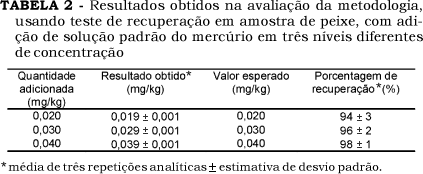In this work, the levels of mercury were evaluated in samples of freshwater fish, coming from fishing-grounds and piscicultures of 39 regions of São Paulo State. The species of fish studied were: pacu (Piaractus mesopotamicus), tilápia (Oreochromis niloticus), piauçu (Leoporinum sp), matrinxã (Brycon cephalus), tambaqui (Colossoma macropomum) and carpa (Cyprinus carpis). Three digestion methodologies of sample were evaluated for the mercury determination, with variation of the volume of sulphonitric mixture utilized and the potassium permanganate concentration. After the validation method the determinations of mercury level were recorded in 293 samples of fish, using the technique of emission spectrometry with plasma coupled to an hydrides generator. The medium levels of mercury found were the following: tambaqui (0,0003-0,012mg/kg), carpa (0,063mg/kg), matrinxã (0,0003-0,074mg/kg), pacu (0,0003-0,078mg/kg), piauçu (0,0003-0,183mg/kg) and tilápia (0,0003-0,217mg/kg), and this last one presented the higher contamination rate. The results showed that none of the samples obtained from the different regions and fish-and-pay establishments presented mercury levels above the permitted limits of Brazilian legislation; 0,5mg/kg for non carnivorous fish.
fish; mercury; determination; emission spectrometry; hydride generator



